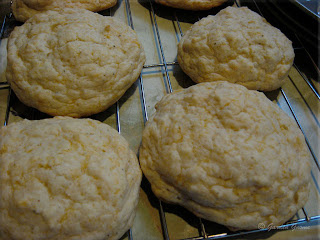 Food Mill
Food MillA food mill is essential for making smooth sauces and juices. I use a Kitchen Value (Home Hardware brand) manual food mill but will soon be switching to the equivalent Kitchen Aid attachment. A food mill removes the peels and seeds making quick work for juicing. The mill attaches to the countertop. Food is fed into the hopper (not shown) then a handle in turned so that the seeds and skins go out the waste shoot (behind) while the juice comes down another shoot into the collecting pan (front). A more detailed picture of the food mill can be found on a previous blog entry here.
Making tomato juice is easy but has a little twist. Tomatoes contain a high level of pectase that is activated when tomatoes are cut. This can lead to separation during storage. To reduce this the tomatoes have to be heated quickly on high heat to destroy the enzyme. When making tomato juice a layer of cut tomatoes is brought to a boil then additional tomatoes are added, crushing them into the mixture until all the tomatoes are heated. The mixture is then brought to a boil, removed from the heat and put through a food mill.
 Tomato Juice
Tomato JuiceAn average of 3 lbs of tomatoes is needed to make 1 L (about 1 quart) of juice. Choose a juicing tomato if possible. Other varieties will work but you will get far less juice out of a paste tomato. If you grow your own consider making juice from yellow tomatoes as well.
I made 14 lovely jars (L & quarts) of tomato juice yesterday. The work was easy enough but a bit drawn out but some of that was due to getting used to the new kitchen. Despite my plans, I didn't start the actual canning process until early evening then had to run the canner twice for processing as it only holds 7 L jars when used as a boiling water bath. So that meant I didn't get my mushroom soup canned but that will likely be today's project along with canning carmelized onions so watch for both of those coming soon.
Home Canned Tomato Juice
recipe for 1 L (quart) jars
3 lb tomatoes per L (quart) jar
2 tbsp lemon juice per jar or 1/2 tsp citric acid
1 tsp sea salt (optional)
Determine how many jars you want to process. My canner holds 7 L or quarts when used for boiling water bath canning. Weight out your tomatoes then wash. Cut into halves or quarters. Start with a layer of tomatoes in a large stainless steel stock pot. Bring to a boil on high heat then add more tomatoes (lg bowl full) at a time to mix in. Continue doing this until all the tomatoes have been added. Bring to a boil. Remove from heat. Run the mixture through a food mill. Return the juice to a large stock pot and bring to a boil. Pour into hot, sterilized litre or quart jars leaving 1/2 inch headspace. Add 12 tbsp lemon juice or 1/2 tsp citric acid per jar. Add salt if desired. Wipe the rim and cap. Process 40 minutes in a boiling water bath canner.

 Peameal Bacon on a Bun
Peameal Bacon on a Bun Processing Tomatoes
Processing Tomatoes Canned Whole Tomatoes
Canned Whole Tomatoes Venison Loaf
Venison Loaf On the Grill
On the Grill Plated
Plated
 Husked Corn
Husked Corn Zucchini & Cabbage Casserole
Zucchini & Cabbage Casserole Quick Cheese Buns
Quick Cheese Buns Corn Relish
Corn Relish Pickled Eggs
Pickled Eggs On the Grill
On the Grill Presentation
Presentation Pickled Beets
Pickled Beets Home Canned Corn
Home Canned Corn Marinating
Marinating Pork Roaster
Pork Roaster On The Roaster
On The Roaster Roasted!
Roasted! Simple Beer Battered Pickerel
Simple Beer Battered Pickerel Draining
Draining Pan Fried
Pan Fried